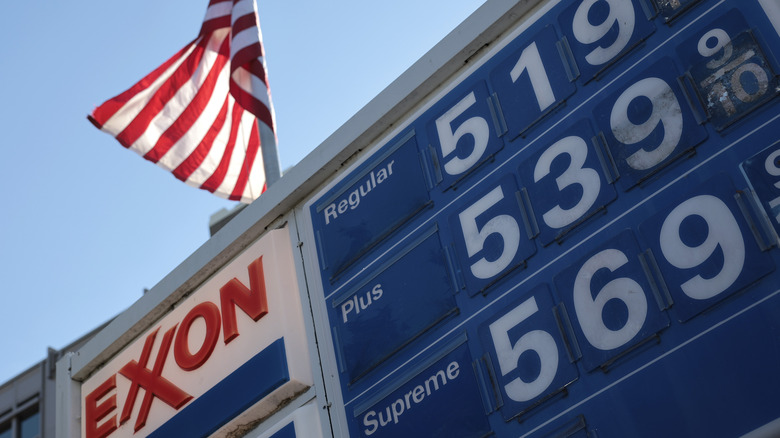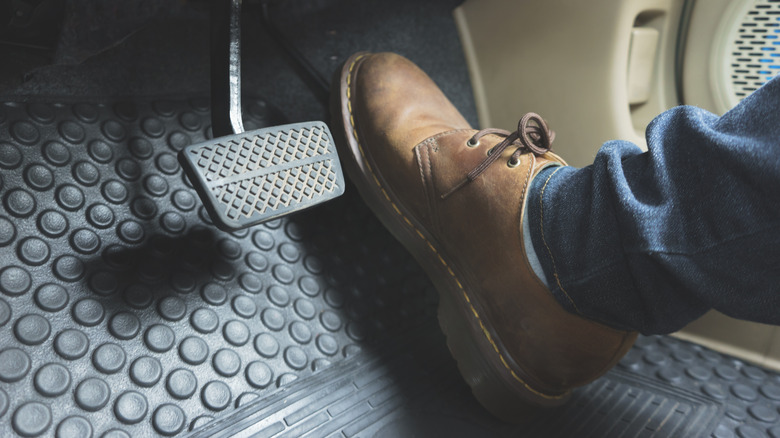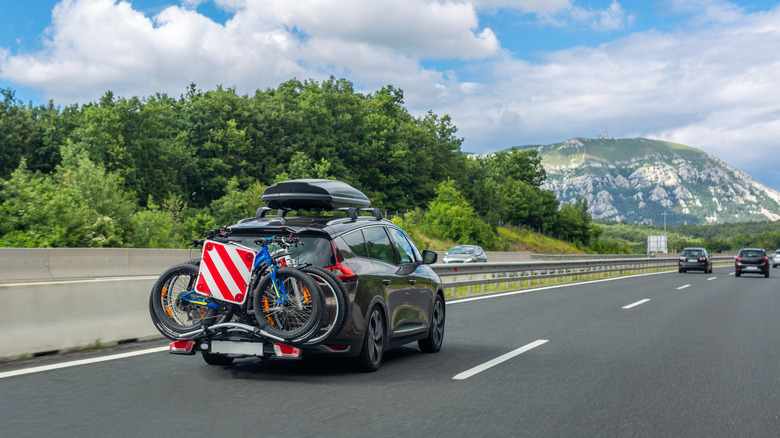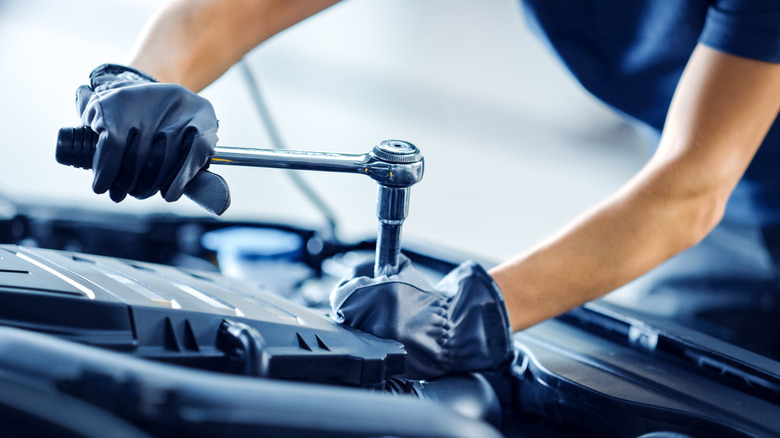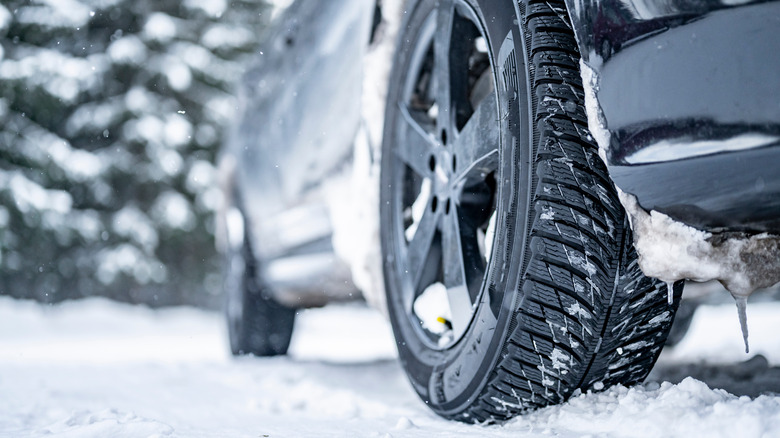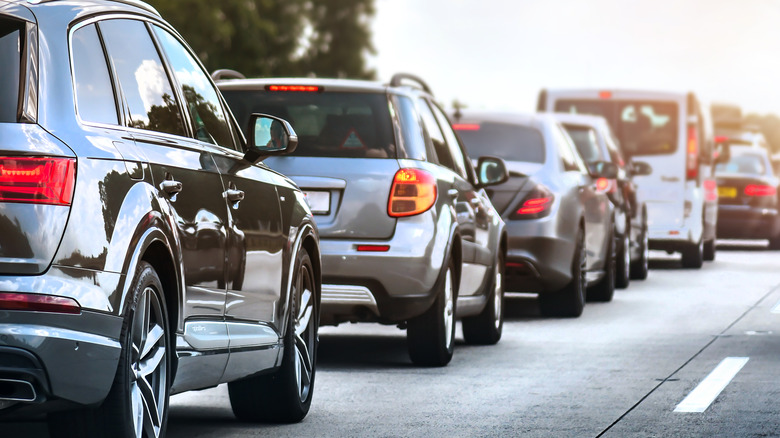The 5 Best Ways To Use Less Gas While Driving
Ongoing supply chain issues, inflation, and geopolitical conflicts around Ukraine have come together and caused fuel prices to spike all around the world. In the United States, a gallon of regular gasoline now averages over four dollars, an 18% increase from February of 2022 (via CNN). This increase has been primarily driven by many European countries cutting their ties to Russian-supplied oil, and the Biden administration is currently attempting new trade deals with other oil producers like Iran and Venezuela to make up the difference and normalize fuel prices (via Wall Street Journal). However, we may still see high costs at the pump in the coming months.
With these record fuel prices, drivers may be more concerned about efficiency than years prior. Purchasing a hybrid or electric vehicle is perhaps the simplest way to alleviate that anxiety, but a new car demands a lot of up-front cost, especially with supplies being extremely limited over the past couple years (via Car and Driver). Even used car prices have been shooting up, and many drivers may not be able to commit to such a large purchase. There are however a few methods drivers can use to wring more efficiency out of their current vehicle, and we'll be highlighting them here in this piece.
Go easy on the throttle
As the name suggests, pushing your vehicle's gas pedal uses a lot of gas, and pushing it down further will consequently use more. In situations where rapid acceleration isn't needed, gently roll onto the throttle when pulling away from stops, to keep your engine in the most efficient range of speed. The EPA and Department of Energy estimate that this habit can use up to 40% less fuel while accelerating. If your car is equipped with a manual transmission, consider shifting at a lower RPM and using top gear whenever possible (via Engineering Explained).
Cruising at slightly slower speeds on the highway can also save fuel. As the EPA points out, most vehicles are at peak efficiency running around 50 miles per hour in top gear. As speed increases past this point, aerodynamic drag causes diminishing returns against engine power. A 2017 study cited by the Department of Energy tested a range of 74 vehicles, and found that they used an average of 12.4% more fuel cruising at 60 mph versus 50 mph. Moreover, upping speeds to 80 mph would cause over a 40% reduction in efficiency, so speeding is an expensive habit.
Eliminate drag & weight
Aerodynamic friction is one of the greatest natural enemies to efficiency. The less drag that a vehicle has, the less the engine will have to work to accelerate and maintain speed, saving fuel. Modern vehicles tend to be designed as aerodynamically as possible, while making some concessions for cabin size, ride height, and safety (via Edmunds). A driver can't typically change the shape of their vehicle to cut down on drag, but there are some small changes that can be made in this regard.
First, remove exterior auto accessories like roof racks and tow mirrors, when not in use. Basically anything that extends the body of a vehicle will cause drag. The EPA estimates that leaving a roof rack on can lead to a 25% increase in fuel consumption at highway speeds. Driving with the windows down can also impact aerodynamic drag. For pickup trucks, installing a hard clamshell cover or camper top over the cargo bed can actually decrease drag by a few percent, and lead to some fuel savings while cruising (via Motor Trend).
Next, see if there are any unnecessary heavy objects inside the vehicle. Power tools or old boxes could be removed, effectively lowering the car's weight, and improving efficiency. Just as with aero drag, a heavier vehicle has to work harder to move. According to the EPA, 100 extra pounds in your vehicle will cause it to use about one percent more fuel, and the effect will be greater in smaller cars.
Keep up on maintenance
A well-maintained vehicle will run at peak efficiency, as well as just run better in general. In particular, make sure to change engine oil and filters at intervals recommended by the manufacturer, or by your car's on-board computer. Leaving old oil in an engine will cause an increase in internal friction, hurting efficiency and eventually causing components to fail. Also, be sure to use the correct oil viscosity denoted by the manufacturer (via EPA).
It's also important to have the car's electronic sensors regularly monitored, and replaced if needed. A malfunctioning engine sensor can cause an improper amount of fuel and air mixture, again leading to a drop inefficiency. For instance, the EPA states that a faulty O2 sensor can drop fuel economy by up to 40%. Fuel system components like the pump, injectors, and spark plugs should also be maintained on schedule to maximize vehicle mileage (via Cars Direct).
Another important aspect is the tires. They'll be at their most efficient when inflated to the manufacturer's specification, provided they have plenty of tread. The EPA claims that "Under-inflated tires can lower gas mileage by about 0.2% for every 1 psi drop in the average pressure of all tires." Running them at an incorrect pressure can also lead to premature and uneven tread wear, costing even more money. If a tire's tread is worn down to about 2/32 of an inch it should also be replaced as soon as possible (via Tire Rack.)
Prepare for hot & cold weather
Extreme temperatures also have a negative impact on vehicle fuel economy. Deep into the summer months, air conditioning consumes a lot of fuel, since the compressor is usually driven directly off of the engine. The EPA estimates that running the A/C can use up to 25% more fuel while driving. Rolling the car's windows down can be more efficient than air conditioning at low speeds, but will also cause increased aerodynamic drag at high speeds.
In colder months, engine fluids also become thicker, and the vehicle takes longer to reach operating temperature. This increases friction, which also reduces efficiency. Tires can slip on snow and ice, which also uses extra fuel. Additionally, cold air particles are grouped more closely together than warm ones, creating more aerodynamic drag. According to the EPA, "a conventional gasoline car's gas mileage is roughly 15% lower at 20°F than it would be at 77°F." In either hot or cold conditions, parking a car in a covered garage can help alleviate these effects. There will be less need for A/C in summer, and the engine will be able to reach operating temperature faster in the winter.
Consolidate trips & avoid idling
Carpooling and combining errands can have a massively great effect on efficiency, since turning two car trips into one can effectively half fuel consumption. It does, of course, require some planning ahead to do effectively (via EPA.) Driving fewer miles will also mean less wear and tear on vehicle components. Also consider planning your trips during off-peak hours to avoid stop-and-go traffic. In 2007, the University of Dresden conducted research showing that cars could consume up to 80% more fuel in congested traffic versus free-flowing streets. This is due to vehicles "idling" at stops, and basically burning fuel for no return.
In 30 minutes of idling, a car can burn up to a half-gallon of gasoline (via SCDHEC). If you find yourself stopped in parking lots or drive-throughs for more than a few minutes, consider shutting down the engine to conserve fuel. In some states, it's even considered illegal to leave your car idling and inactive (via NCSL). Many newer vehicles have also implemented auto start-stop features, which automatically shut down and restart the engine at stops, saving fuel and cutting down on tailpipe emissions (via AutoWeek).
